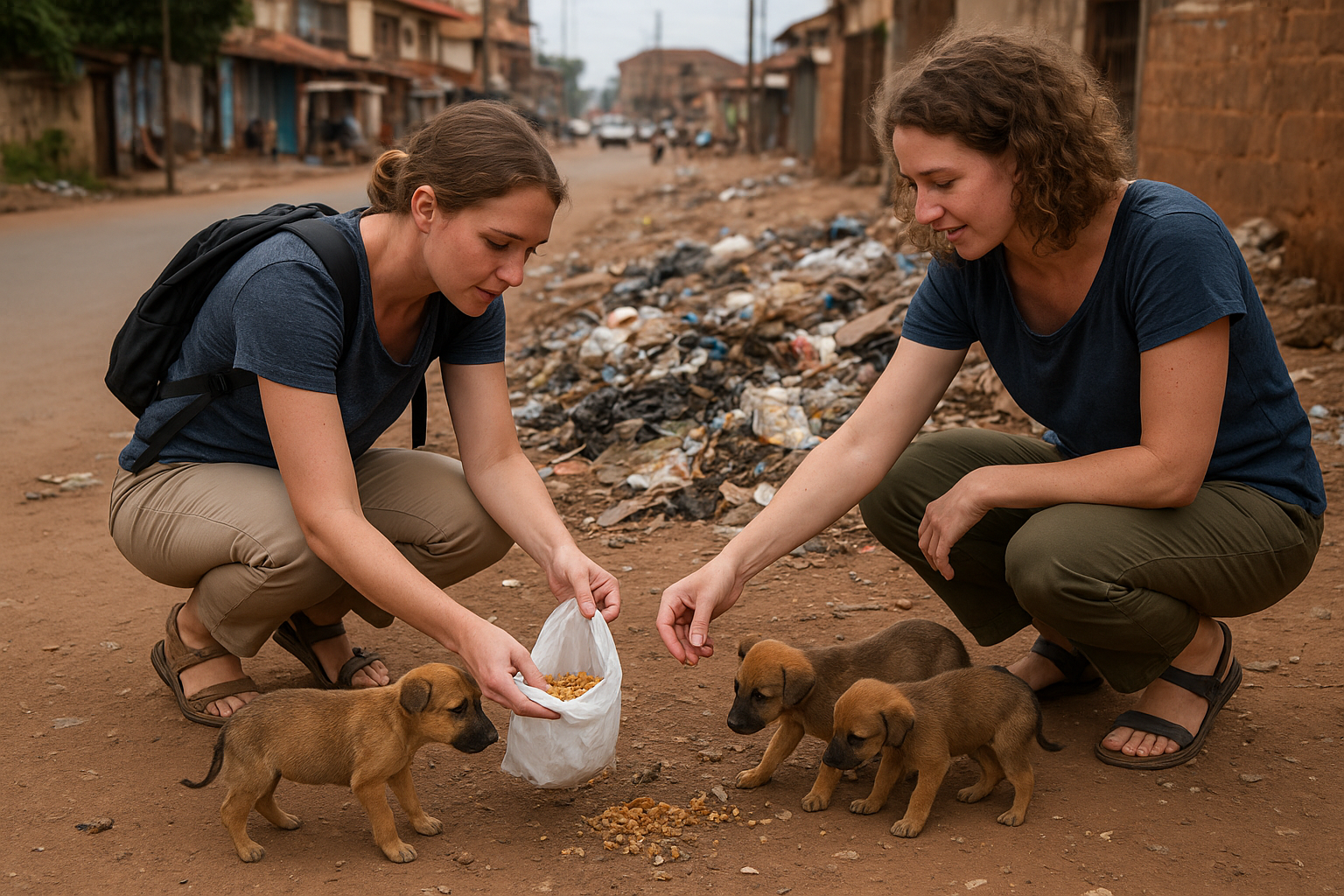
Why Stray Animals in Uganda Need Our Compassion
Imagine walking through the bustling streets of Kampala—motorbikes weaving past, street vendors calling out, children laughing—and then noticing a small, trembling dog hiding in a corner, its ribs visible under patchy fur. Or a cat quietly scavenging through a pile of trash, searching for its next meal. These are the faces of Uganda’s stray animals, millions of innocent creatures living without shelter, regular food, or medical care.
Stray dogs and cats in Uganda face harsh realities every day. They are vulnerable to starvation, diseases like rabies and distemper, injuries from traffic accidents, and cruel treatment from humans. Without intervention, their lives are short, painful, and uncertain.
For expats and residents alike, encountering these animals can be both heartbreaking and overwhelming. The truth is that many strays were once pets, abandoned due to financial constraints, relocation, or neglect. Others are born on the streets due to uncontrolled breeding. Regardless of how they ended up there, these animals share a common need: compassionate human help.
Helping strays isn’t just about feeding them—it’s about providing safety, medical care, and hope for a better life. Every meal you offer, every vet visit you support, and every adoption you consider can transform their world. For expats living in Uganda, there’s a unique opportunity to make a real difference—whether by volunteering, donating, or welcoming a stray into your home.
In this guide, we’ll explore practical, actionable ways to help stray animals in Uganda, from identifying who needs help, to caring for them at home, to finding reputable veterinary support like Superior Animal Clinic in Makindye, which specializes in treating and rehabilitating strays. By the end, you’ll not only understand the plight of these animals but also know exactly how to be part of the solution—making life safer, healthier, and kinder for some of Kampala’s most vulnerable residents.
Understanding Stray Animals in Uganda: The Heart of the Issue
Seeing a dog or cat roaming the streets of Kampala can tug at anyone’s heartstrings, especially for expats who may be used to stricter animal control in their home countries. To truly help, it’s important to understand why these animals end up on the streets and where they are most concentrated.
Why So Many Stray Animals in Kampala, Uganda?
Stray animals in Uganda, particularly dogs and cats, often find themselves abandoned or born into street life due to:
- Abandonment: Some owners give up pets due to financial difficulties, moving, or lack of knowledge about proper care.
- Overpopulation: Many animals are unneutered, leading to litters that owners cannot manage. Puppies and kittens are often left to fend for themselves.
- Economic Factors: In lower-income neighborhoods, families may struggle to feed or care for pets, resulting in more animals roaming freely.
- Lack of Awareness: Not all residents understand the importance of vaccinations, sterilization, or responsible pet ownership.
- Accidents or Loss: Some pets escape or get lost and cannot find their way back home.
Areas in Kampala With the Highest Number of Strays
Expats may notice that certain neighborhoods have far more strays than others. Kampala hotspots include:
- Kalerwe and Bwaise: These bustling markets and densely populated areas have many street dogs. The heavy foot traffic, food waste, and open spaces attract animals, but also expose them to dangers like traffic and disease.
- Wandegeya: A busy student and commercial hub where stray cats and dogs often scavenge for leftover food.
- Old Kampala: Narrow streets and informal settlements make it easy for strays to survive but hard for them to find shelter.
- Nakawa: Streets with markets and industrial areas see strays searching for scraps, often at risk of accidents.
- Makindye (near Superior Animal Clinic): While residential, areas here still have roaming animals due to abandoned pets or litters from unspayed animals.
Interactive Thought: Next time you walk through these neighborhoods, take a moment to observe the strays. Notice how they move, how they interact with humans, and how they survive. This observation is the first step to understanding their needs.
The Emotional Reality
Stray animals are not just numbers—they are sentient beings experiencing hunger, fear, and uncertainty every day. A kitten huddled under a roadside stall or a dog dodging traffic is struggling to survive, yet they often show incredible resilience and trust in humans.
For expats, connecting emotionally can be powerful:
- Imagine a young puppy shivering in the rain, looking for its next meal.
- Picture a mother cat protecting her kittens from danger while searching for scraps.
- Every animal has a story—often one of abandonment, struggle, and survival.
How to Identify a Stray Dog or Cat in Uganda
In Uganda, it’s common to see dogs or cats roaming around markets, roadsides, or compounds — but not every free-roaming animal is truly homeless. Some pets are allowed to wander during the day, while others have been abandoned or born on the streets. Knowing how to tell the difference is the first step toward helping responsibly.
Let’s walk through how to identify a stray in a compassionate, practical way.
🐶 Step 1: Observe the Animal’s Appearance
The first clues come from how the animal looks.
- Body Condition: Stray animals often appear thin, with visible ribs, dull coats, or bald patches from mange or fleas.
- Cleanliness: A pet that’s regularly bathed will have a shinier coat, while a stray may look dusty, muddy, or matted.
- Injuries: Look for cuts, limps, or scars—common among strays who struggle to survive on the streets.
- Facial Expression: Strays often have a wary, anxious look; pets tend to appear more relaxed and confident around people.
Try this: The next time you see a roaming dog or cat in areas like Kalerwe, Bwaise, or Old Kampala, quietly watch its body language. Does it look tired, hungry, or nervous? That’s often a sign it’s fending for itself.
🏷️ Step 2: Check for Identification or Collars
Collars can say a lot.
- A clean, fitted collar or tag usually means the animal has an owner.
- A tight, old, or broken collar might suggest it was once owned but has been neglected or abandoned.
- Many owned pets in Uganda don’t have ID tags, so ask around before assuming ownership.
Pro tip: Politely ask nearby boda riders, kiosk owners, or neighbors if they’ve seen the animal before. Locals are usually very observant—they’ll often know whether it belongs to someone or if it’s been roaming for weeks.
🍗 Step 3: Watch How It Behaves Around People
Behavior can reveal a lot about an animal’s history with humans:
- Friendly and calm: May belong to someone nearby. Some owned pets in Uganda roam freely but always return home.
- Cautious but curious: Might be a stray that has had some kind contact from people before.
- Fearful, trembling, or aggressive: Likely a stray that’s been mistreated or has had little human interaction.
If a dog wags its tail from a distance but won’t approach, it might want help but is scared — a common sign of an abandoned pet.
Interactive idea: Carry a small piece of boiled chicken or dog biscuit (available at vet shops like Superior Animal Clinic). Offer it gently—if the animal approaches cautiously, it’s a sign of hunger and need, not aggression.
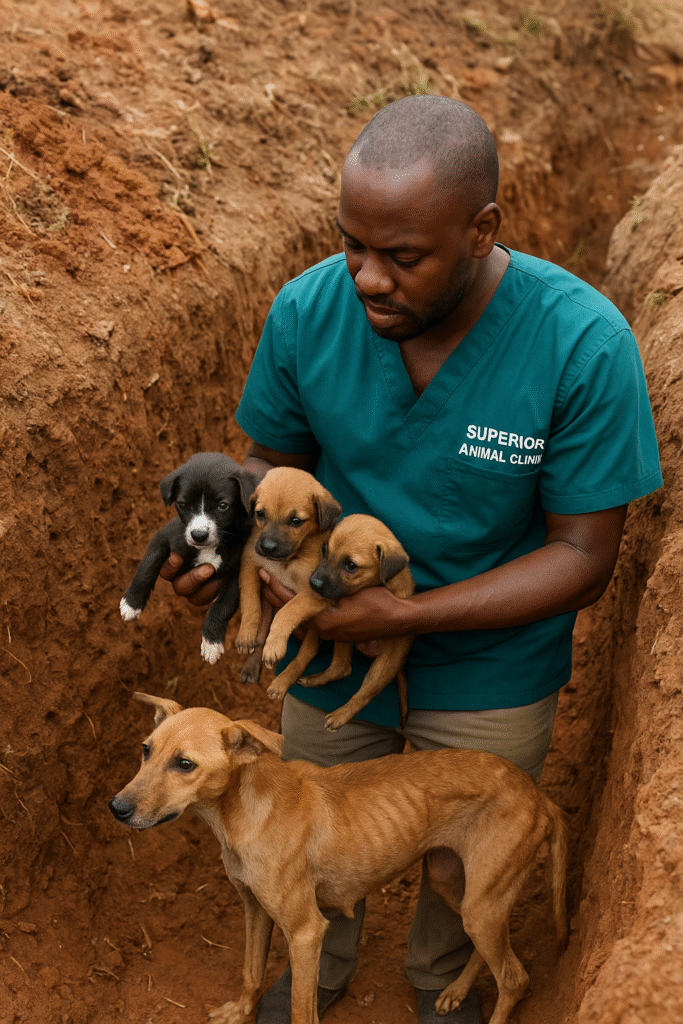
Step 4: Notice Its Habits and Location
Where and how an animal lives gives strong clues:
- Hanging around garbage piles or market stalls (e.g., Kalerwe Market): Likely scavenging to survive.
- Sleeping under cars, verandas, or roadside kiosks: Common behavior for homeless animals seeking warmth and shelter.
- Following people or cars: Hungry or abandoned pets often follow anyone who shows kindness.
If a dog or cat always appears at the same corner, it may have “claimed” that area as its safe zone — a telltale stray behavior.
Step 5: Ask the Community
Don’t underestimate the power of local knowledge!
- Ask security guards, boda-boda riders, food vendors, and shopkeepers if the animal has an owner.
- In some communities, dogs are “semi-owned” — they may get scraps from locals but sleep outdoors with no one fully responsible for them.
- If nobody claims it, it’s likely a true stray.
Real story moment: Many expats have found their adopted pets this way — by asking around and realizing no one truly “owned” the animal that everyone just called the shop dog or the market cat.
Step 6: Trust Your Instincts
Your empathy is a valuable tool. If your heart tells you that animal looks lost, scared, or in distress — you’re probably right.
Strays often look to humans with cautious hope. They may be weak, dirty, or hesitant, but the moment they sense safety, their eyes soften and their tails may start to wag.
Emotional takeaway: Behind every stray in Uganda is a story — maybe a puppy born behind a market stall, or a cat abandoned when its owner moved. Recognizing their struggle is the first act of compassion.
Ways Expats Can Help Strays in Uganda
Helping strays doesn’t always mean adopting. Here are actionable ways to make a difference:
1. Provide Food and Water
- Place small amounts of food and clean water in shaded, safe areas.
- Avoid feeding near busy roads to prevent accidents.
- Coordinate with local residents or shelters for regular feeding schedules.
2. Support Local Shelters and Rescue Organizations
Shelters play a critical role in caring for strays. Some trusted options in Uganda include:
- Superior Animal Clinic – Makindye, Kampala: Known for professional veterinary care, treatment of injuries, vaccinations, and facilitating stray adoption. Highly recommended for expats and locals alike.
- Hope for Dogs Uganda
- Kampala Animal Rescue Center
- Animals Uganda
You can help through donations, volunteering, or sharing awareness campaigns.
3. Organize or Join Spay/Neuter Programs
- Uncontrolled breeding is a major cause of stray overpopulation.
- Partner with local vets, including Superior Animal Clinic, to provide low-cost sterilization clinics.
- Educate communities on responsible pet ownership.
4. Provide Medical Care
- Minor injuries can be treated at home, but professional care is essential for serious issues.
- Superior Animal Clinic offers vaccination, deworming, wound treatment, and rehabilitation for strays.
- Keep a first-aid kit ready for minor cuts, infections, or flea treatment.
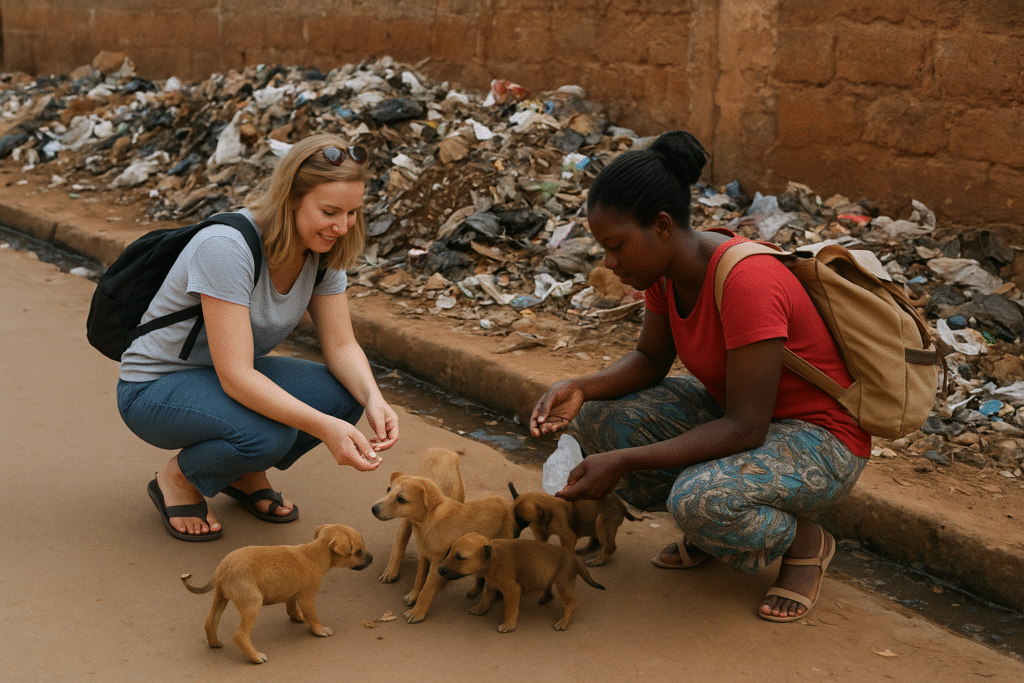
Caring for a Stray at Home in Uganda
So, you’ve found a dog or cat that looks lost, hungry, or frightened — and your heart tells you to help. Bringing a stray animal home in Uganda is a deeply rewarding act of compassion, but it also requires patience, understanding, and proper care. Many of these animals have never known love or safety before, so your kindness could be the first gentle touch they ever feel.
Here’s how to care for a stray at home responsibly, safely, and with love.
🏡 Step 1: Create a Safe and Calm Space
A newly rescued animal will likely be anxious and disoriented. The first thing they need isn’t toys or food — it’s safety.
- Prepare a quiet corner of your house, balcony, or compound. Use a box, mat, or old blanket for comfort.
- Keep the environment calm — avoid loud noises, children chasing, or other pets until the stray settles in.
- Limit space at first. Too much room can overwhelm them. Gradually expand their freedom as they grow comfortable.
Tip: Many expats in Kampala find success using a spare bathroom, laundry area, or gated veranda as a starter space.
Emotional note: The first night is often the hardest — but also the most powerful. That scared animal sleeping safely for the first time in weeks will begin to trust again, because of you.
🍲 Step 2: Feeding and Hydration
Stray animals are often malnourished, so start gently.
- Go slow: Offer small portions of food several times a day instead of large meals.
- Best starter foods: Boiled rice with plain chicken, or soft tinned food for cats. Avoid spicy or oily Ugandan food — it can upset their stomach.
- Water: Always provide clean, fresh water in a bowl that’s easy to reach.
- Transition gradually: Once the animal stabilizes, shift to quality dog or cat food (available at veterinary shops or at Superior Animal Clinic in Makindye).
Pro Tip: Don’t be surprised if they guard their food or eat quickly — it’s survival behavior. With consistent meals, they’ll learn they don’t have to fight for food anymore.
🩺 Step 3: Veterinary Care — The Most Important Step
Before anything else, ensure the animal’s health and safety. Many strays carry ticks, worms, or infections that need prompt treatment.
Bring your new friend to a trusted veterinary clinic for:
- Full health examination – to check for diseases, injuries, and parasites.
- Vaccinations – especially against rabies and parvovirus.
- Deworming and flea/tick control.
- Spay or neuter surgery – to prevent future unwanted litters.
💙 Where to Go:
Superior Animal Clinic (Makindye, Kampala) is widely regarded as the best veterinary clinic for stray animals in Uganda. Their caring team understands the unique needs of rescued pets. They offer affordable treatment, sterilization, and personalized follow-up for animals recovering from street life.
They can also help with:
- Adoption certificates (if you plan to officially adopt)
- Ongoing vaccinations and preventive care
- Behavior and training advice for adjusting strays
Emotional insight: Watching a once-weak stray walk confidently out of the vet clinic after treatment is one of the most heartwarming moments you’ll ever experience.
🧡 Step 4: Building Trust and Emotional Healing
Street animals often carry invisible wounds — fear, mistrust, or trauma from neglect. Healing takes time and consistency.
- Speak softly: Use calm tones and avoid sudden movements.
- Respect boundaries: Let them approach you when they’re ready.
- Reward kindness: Gentle praise, a treat, or even soft eye contact builds confidence.
- Routine is love: Feed, walk, and play at the same times each day. Routine gives them a sense of safety.
Interactive exercise: Try sitting quietly near them for a few minutes daily without touching. Just let them feel your presence. Over time, they’ll come closer — sometimes even lean in for their first touch of affection.
🏋️♂️ Step 5: Gentle Training and Socialization
Once your stray starts to feel secure, introduce light training and socialization.
- For dogs: Begin with short leash walks around your compound. Reward calm behavior with praise or small treats.
- For cats: Provide a litter box, scratching post, and toys. Avoid forcing cuddles.
- Introduce other pets slowly and under supervision.
- Encourage play — it rebuilds trust and reduces anxiety.
Pro Tip: Superior Animal Clinic’s vets and staff can recommend local dog trainers or give you behavioral tips for nervous rescues.
Step 6: Preparing for Adoption or Long-Term Care
If you plan to keep the animal, congratulations — you’ve changed a life! But even if you can’t, you can still help them find a home.
- Share their story on social media or local expat groups (with clear, kind photos).
- Work with Superior Animal Clinic or local shelters to arrange adoption.
- Ensure the new owner commits to proper feeding, vaccination, and sterilization.
Emotional truth: Even if you can’t keep them forever, giving a stray a clean body, full stomach, and safe night’s sleep is an act of love they will never forget.
Safety Tips for You and Your Household
- Always wash hands after handling strays.
- Keep children supervised until the animal is fully socialized.
- Quarantine new animals from your pets for at least 10–14 days.
- Use gloves when cleaning wounds or handling ticks.
- Make sure your own pets are up to date on vaccinations before bringing a stray home.
❤️ The Reward
Caring for a stray animal in Uganda is more than an act of kindness — it’s a bridge between worlds. You take a creature that has known only hunger and fear, and you show it warmth, safety, and belonging.
When that stray finally wags its tail or curls up peacefully on your doorstep, it’s not just gratitude — it’s trust reborn.
Your home becomes a place of healing, and your heart becomes part of Uganda’s growing community of compassionate pet lovers.
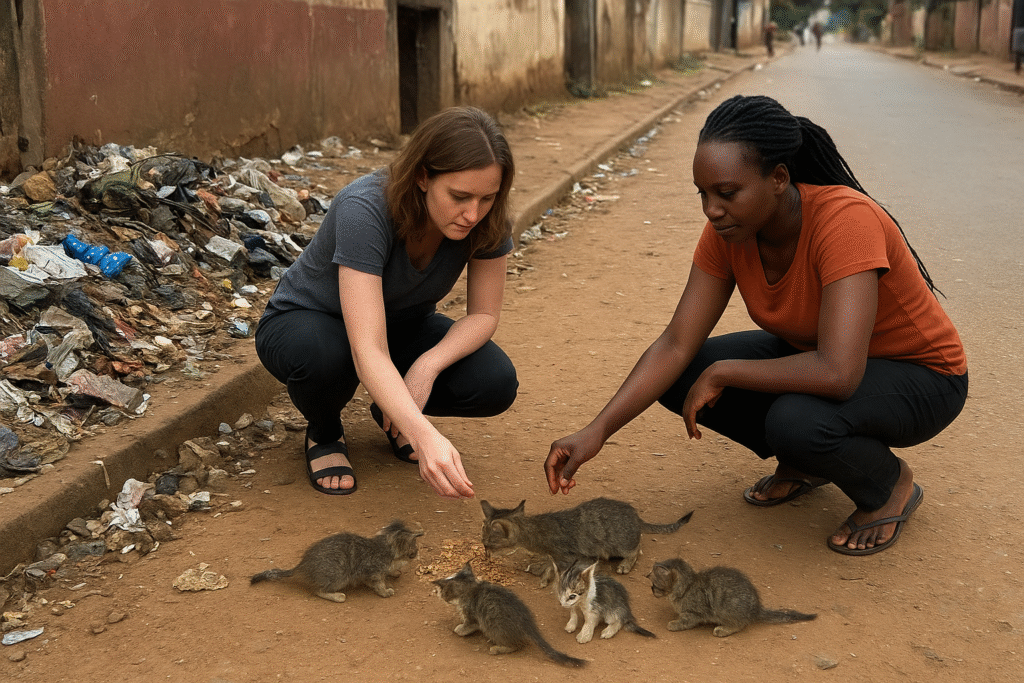
🐾 Steps to Adopt a Stray Dog or Cat in Uganda
Adopting a stray in Uganda is one of the most fulfilling acts of kindness you can do — it saves a life, reduces street suffering, and brings immense love into your home. However, it’s important to follow the right steps to ensure your new furry friend is healthy, legal, and well-adjusted. Here’s a practical and heartfelt guide tailored to Uganda’s real conditions and systems.
1. Confirm the Animal Is Truly a Stray
Before adopting, ensure the cat or dog doesn’t already belong to someone. In some Kampala neighborhoods like Muyenga, Kisaasi, and Ntinda, pets can sometimes wander off.
Check for clues:
- Collars or tags – Some pets have makeshift collars or strings.
- Ask around – Talk to boda riders, local shopkeepers, and neighbors; someone might recognize the pet.
- Post on community pages – Facebook groups such as Pets Uganda or Lost and Found Pets Kampala can help confirm if the animal is missing.
If no one claims them after a few days, it’s likely the pet is truly a stray and ready for a second chance.
2. Visit a Trusted Vet (Start with Superior Animal Clinic)
Before bringing the stray permanently into your home, schedule a full veterinary check-up.
Superior Animal Clinic in Makindye along Salaama Road, Kampala, is one of the most trusted clinics for rescuing, examining, and rehabilitating strays.
Their team will:
- Check for diseases and parasites (like ticks, worms, or mange).
- Test for infectious conditions such as parvovirus or feline leukemia.
- Start vaccinations (especially anti-rabies, parvo, and distemper).
- Offer neutering/spaying to prevent more strays.
- Provide a health card, which you’ll need for adoption proof.
📞 You can reach Superior Animal Clinic at 0771909946 for appointments or advice before bringing in a rescued stray.
3. Prepare Your Home for Adoption
A rescued animal needs safety, comfort, and patience. Uganda’s climate and lifestyle require some special preparation:
For dogs:
- Create a secure fenced area (especially if you live in open compounds).
- Provide shade and water – Kampala gets very hot!
- Gradually introduce the dog to new people and other pets.
For cats:
- Keep them indoors at first, especially if they were street cats.
- Provide a litter box and soft sleeping spot.
- Avoid loud noises; it helps them adjust faster.
4. Legal and Ethical Considerations in Uganda
Uganda doesn’t have a centralized pet adoption authority like in the West, but there are responsible practices to follow:
- Keep vet records from Superior Animal Clinic or any registered vet — they serve as your ownership proof.
- Vaccinate against rabies (it’s required by Ugandan law for public safety).
- Register your pet locally if possible — some local councils allow pet registration to prove ownership.
- Always handle adoption ethically — never buy strays from sellers on the street; instead, adopt and rehabilitate.
5. Socialize and Train Your New Pet
Strays often need extra time to trust humans again. Training should be gentle and patient:
- Use positive reinforcement — reward calm behavior with treats or praise.
- Take dogs for short walks to build confidence.
- For cats, use interactive play with strings or toys to bond.
- Superior Animal Clinic can guide you on behavioral training and post-adoption care for rescued pets.
6. Spread Awareness and Encourage Others
Every adoption story matters. Share your experience with friends, on social media, or in your neighborhood.
When others see your compassion, they might be inspired to help too — slowly reducing the number of strays on Kampala’s streets.
❤️ Final Thought
Adopting a stray in Uganda is not just about saving a pet; it’s about restoring hope.
Each dog or cat that finds a loving home becomes a symbol of what compassion can achieve — one act of kindness at a time.
And remember, Superior Animal Clinic is always ready to help you through every step of the adoption journey — from rescue to recovery to lifelong care.
📍 Location: Makindye, along Salaama Road, Kampala
📞 Contact: 0771909946
🌐 Website: superioranimalclinicvet.com
Community Engagement: Making a Broader Impact
- Neighborhood awareness: Educate neighbors in high-stray areas like Bwaise and Wandegeya about humane animal care.
- School campaigns: Teach children and adults about compassion for animals and responsible ownership.
- Fundraising events: Partner with local businesses to support shelters and veterinary services.
Safety Tips for Expats
- Avoid direct contact if unsure of the animal’s temperament.
- Wash hands thoroughly after handling or feeding.
- Ensure personal vaccinations, particularly rabies, are up to date.
- Use gloves when giving first aid to prevent disease transmission.
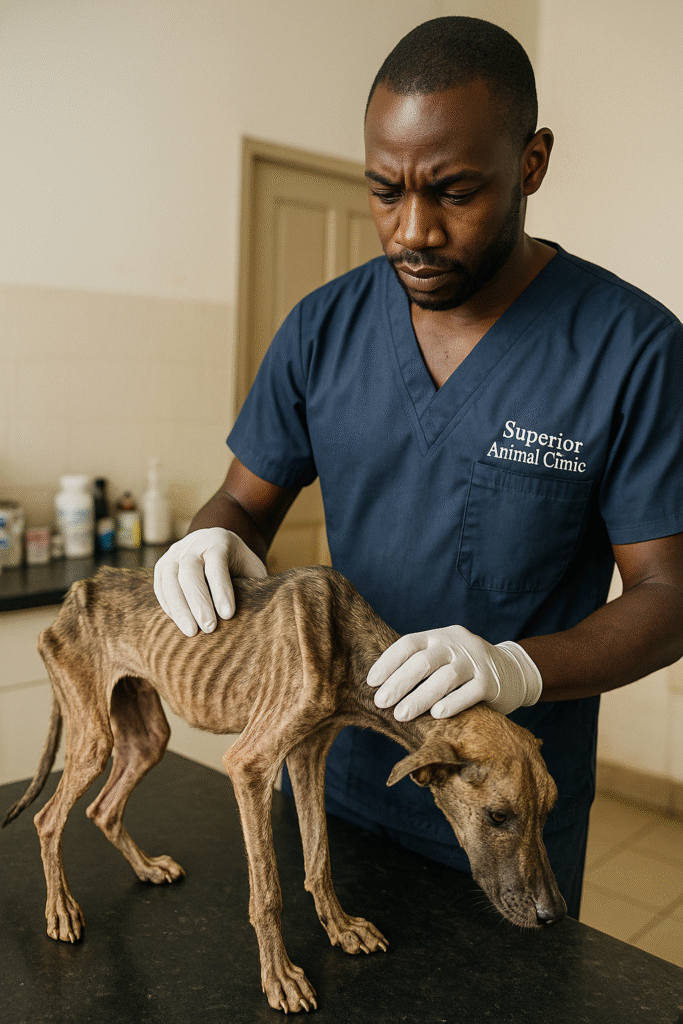
Why Choose Superior Animal Clinic for Strays
When helping strays in Uganda, Superior Animal Clinic in Makindye stands out because:
- Experienced vets specialized in stray animal care
- Affordable treatment, vaccination, and sterilization programs
- Adoption facilitation and community outreach
- Excellent reputation among expats and local residents
They provide professional guidance, ensuring that strays get a healthy start before moving to their new homes.
Quick Action Checklist for Expats
✅ Identify true strays
✅ Provide food, water, and temporary shelter
✅ Support shelters and local rescue programs
✅ Organize or join spay/neuter campaigns
✅ Seek veterinary care at Superior Animal Clinic
✅ Adopt responsibly and legally
✅ Educate neighbors and communities about humane treatment
🐶 FAQs on Adopting Stray Dogs and Cats in Uganda
1. How can I adopt a stray dog or cat in Uganda?
To adopt a stray in Uganda, first confirm it’s not someone’s lost pet by asking around your neighborhood or posting on Facebook groups like Pets Uganda. Then, take the animal to a trusted vet such as Superior Animal Clinic in Makindye, Salaama Road, Kampala for a health check, vaccinations, and adoption guidance.
2. What areas in Kampala have the highest number of stray animals?
Neighborhoods like Makindye, Katwe, Kabalagala, Nsambya, Kawempe, and Kasubi have the highest stray dog and cat populations in Kampala. These areas face challenges like poor waste management and open food sources, which attract unowned animals.
3. How can I tell if a dog or cat is a stray in Uganda?
Look for signs such as malnourishment, visible ribs, ticks, or skin wounds. Strays are often cautious or fearful but may approach slowly when offered food. Unlike owned pets, they rarely wear collars or look well-groomed.
4. What should I do after rescuing a stray animal in Kampala?
Keep the animal safe and calm, then contact a vet. Superior Animal Clinic (0771909946) offers emergency care, parasite treatment, vaccinations, and guidance for new rescuers. They can also issue a health card for proof of ownership.
5. Do I need legal documents to adopt a stray animal in Uganda?
While Uganda doesn’t have a formal adoption system, vet records from Superior Animal Clinic serve as proof of ownership. You must ensure your pet is vaccinated against rabies, which is a legal requirement in Uganda.
6. How much does it cost to adopt a stray dog or cat in Uganda?
Adoption itself is free, but you’ll need to cover veterinary care costs such as:
- Vaccinations (UGX 50,000–150,000)
- Deworming and parasite control (UGX 20,000–70,000)
- Spay or neuter surgery (UGX 150,000–450,000)
- Food and shelter setup (UGX 100,000–200,000)
These prices vary slightly by clinic and animal size.
7. How can I care for a stray animal at home in Uganda?
Provide a quiet space, nutritious food, and clean water. Keep the animal indoors or fenced in, and slowly socialize them. Regular vet visits to Superior Animal Clinic will help track progress, prevent diseases, and build trust with your new pet.
8. Why should I take a stray to Superior Animal Clinic in Kampala?
Superior Animal Clinic is known for its compassionate approach to rescuing, treating, and rehabilitating stray dogs and cats. Located along Salaama Road in Makindye, the clinic provides full vet care — from emergency rescue to vaccination, spaying, and long-term wellness.
9. What are the benefits of adopting a stray animal in Uganda?
Adopting a stray saves a life, reduces suffering on the streets, and brings emotional fulfillment. Stray pets are often loyal and deeply grateful when given a second chance. It also helps reduce the overpopulation of homeless animals in Kampala.
10. Who can I contact for help with a stray animal in Kampala?
Reach out to Superior Animal Clinic at 📞 0771909946 or visit them along Salaama Road, Makindye, Kampala. Their caring team will advise you on rescue, treatment, vaccination, and how to successfully adopt a stray dog or cat in Uganda.
Final Thoughts
Helping stray animals in Uganda is a rewarding experience. Whether it’s feeding a hungry street dog, volunteering at a shelter, or adopting a stray, your actions can save lives. As an expat, you can make a tangible difference while fostering compassion in your community.
Start small, be consistent, and rely on trusted partners like Superior Animal Clinic to ensure the animals receive the care they deserve. Your efforts can transform the lives of strays in Kampala and beyond.
